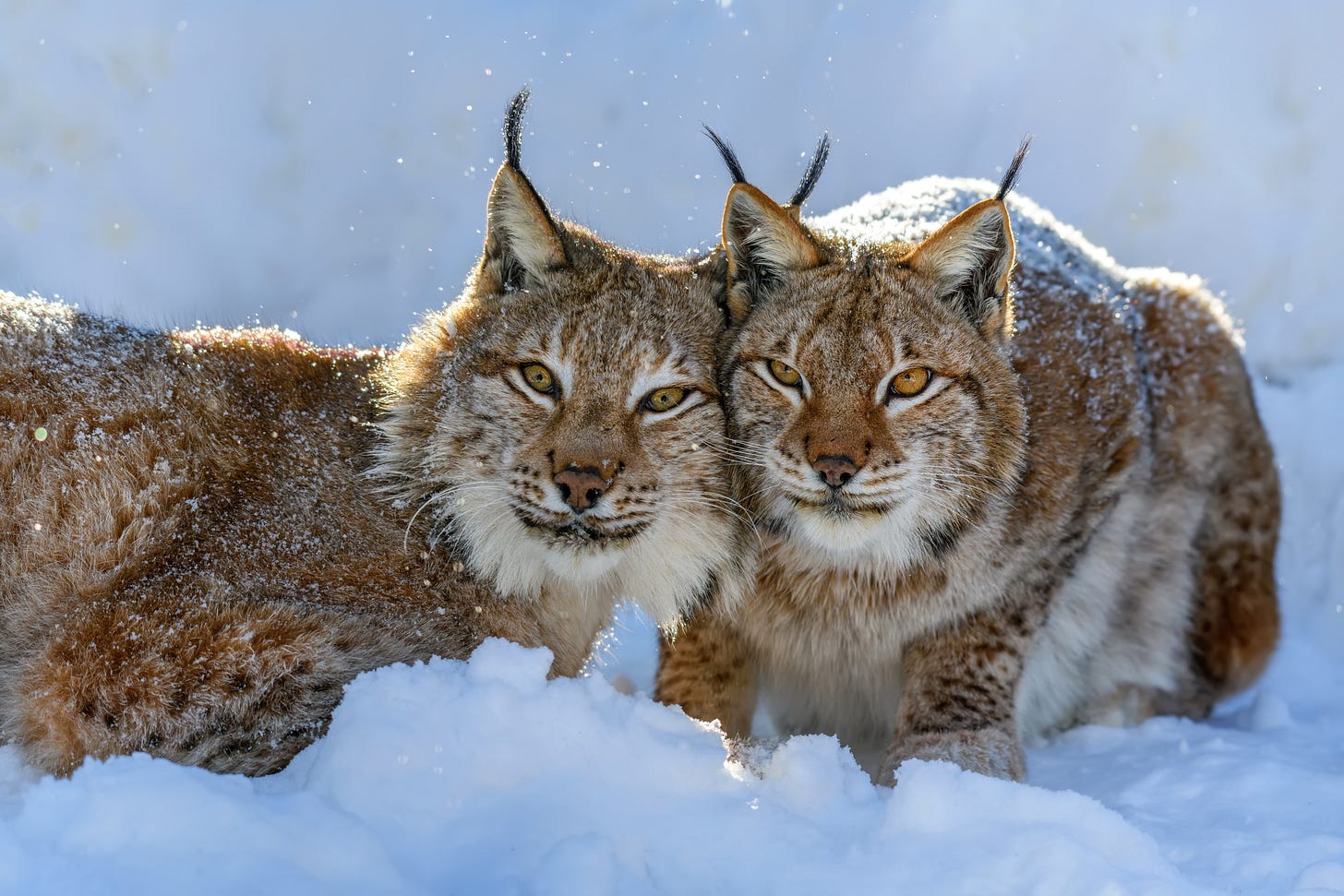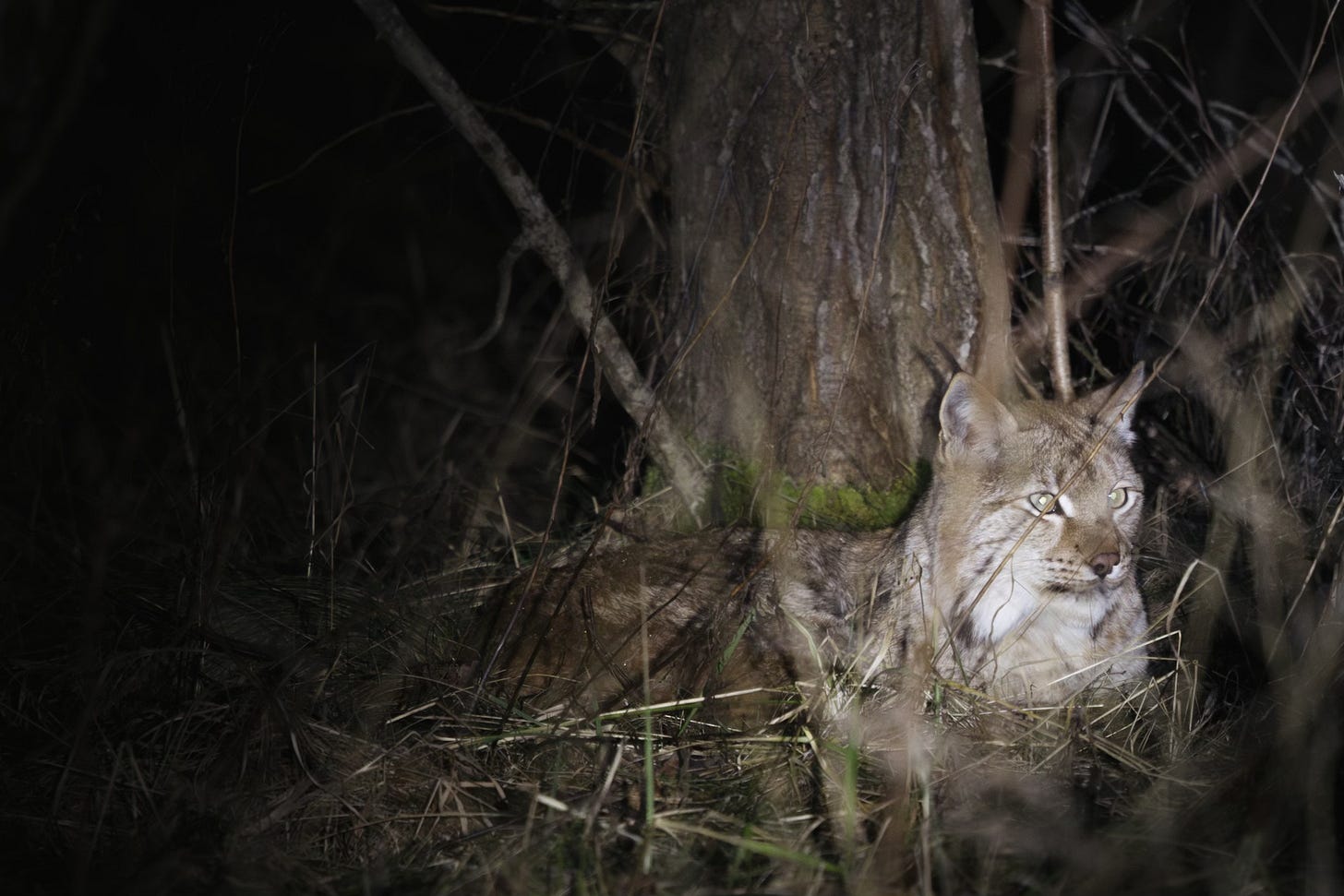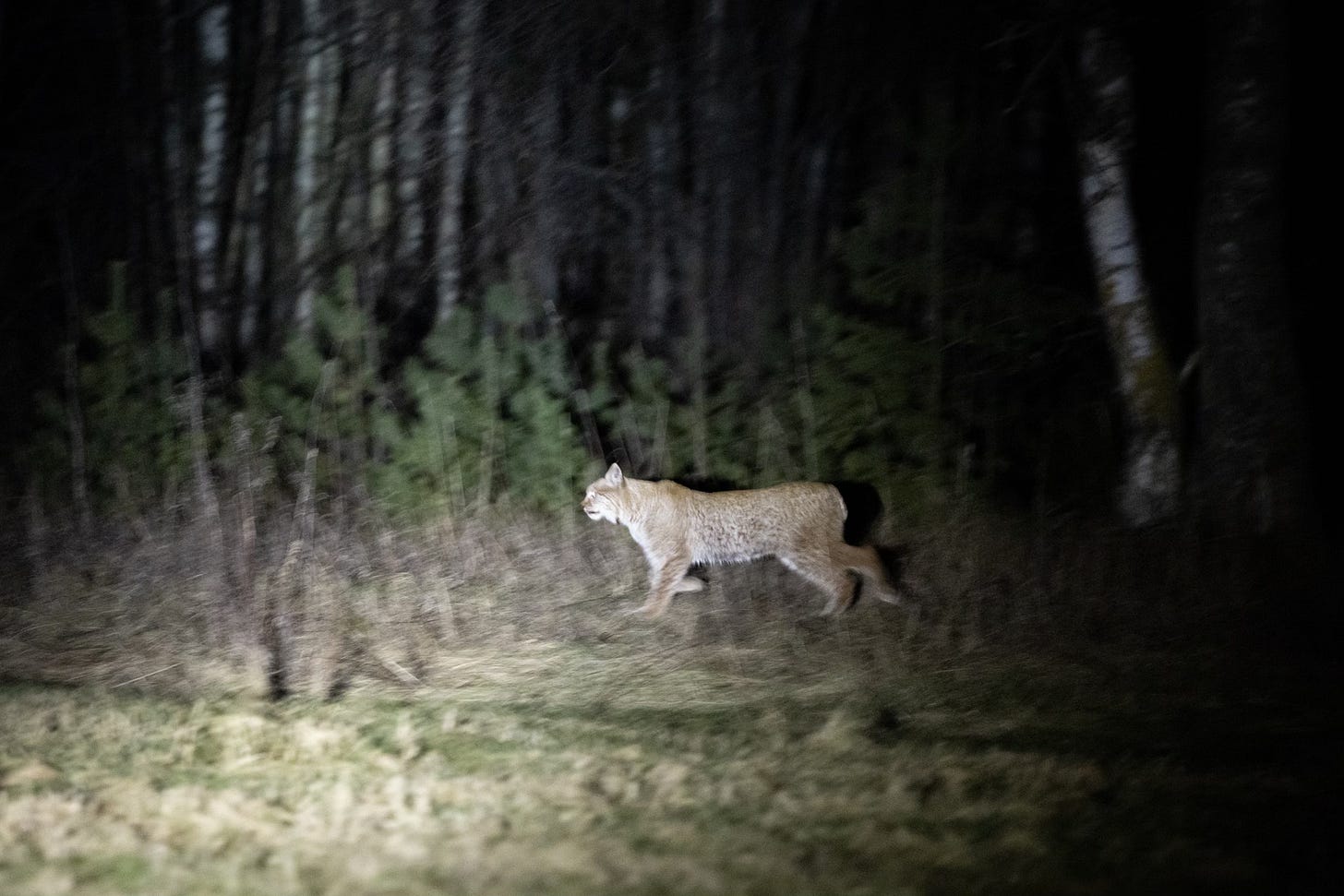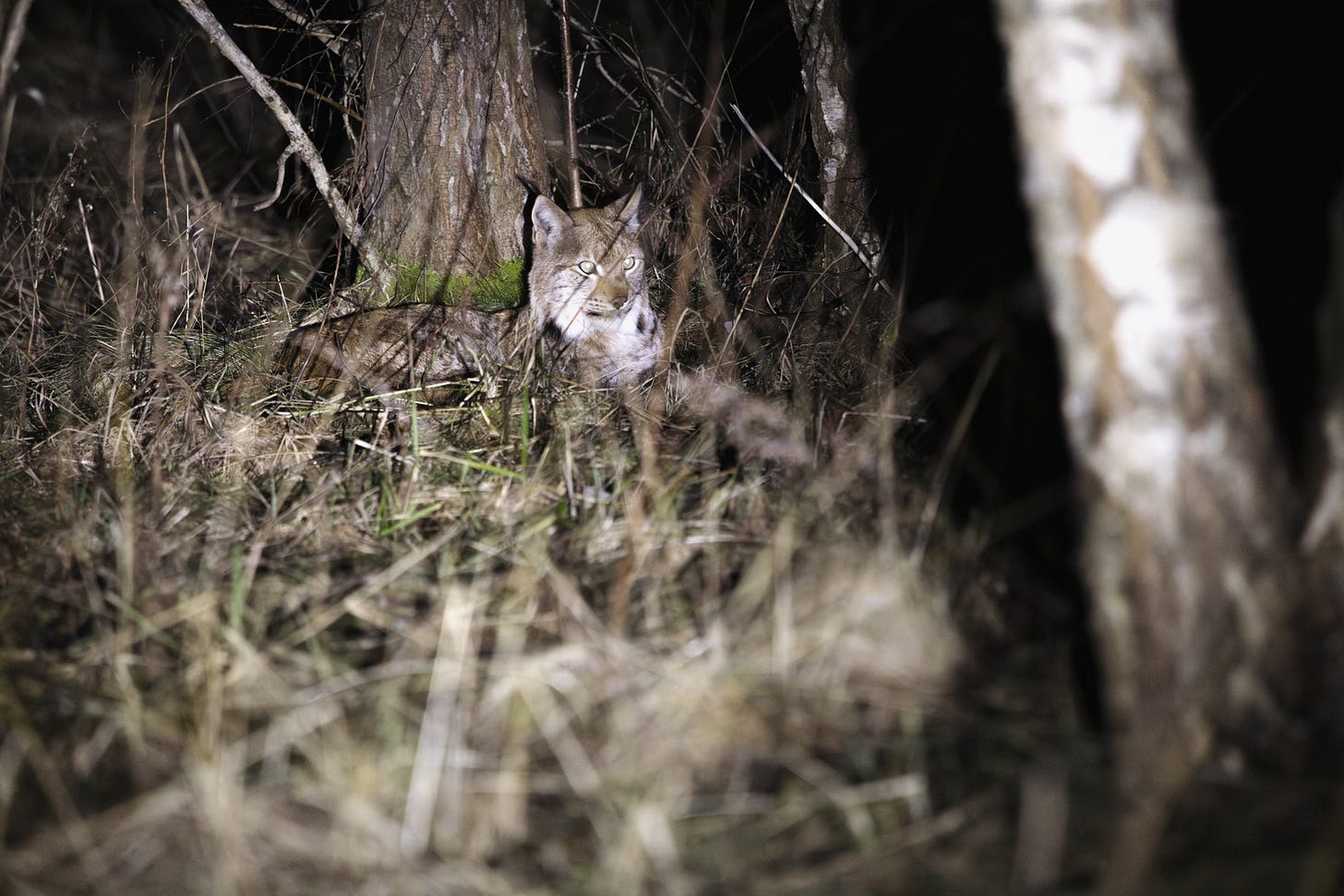A night pursuit through a frozen forest
Plus, how a hunting moratorium turned killings into conservation while Sweden continues to hunt lynx during mating season.
By Dan Fletcher
You might wonder why Americans should care about predator conservation halfway around the world. As I’m learning, Estonia's experience offers valuable lessons for our own struggles with predator management. While states like Colorado have had deep divisions around wolves and mountain lions, Estonia provides a compelling case study in how quickly wildlife populations can collapse—and how communities can pivot from traditional hunting to more sustainable wildlife tourism. Here’s my report from Lahemaa National Park, along with today’s audio edition.
The Estonian coast during late winter feels abandoned. Hotels and country clubs that fill up on weekends with locals seeking saunas sit empty during the week. It makes sense—the days are gray, alternating between bone-chilling cold and dispiriting rain.
But as the sun begins to set, something strange happens along the quiet forest roads of Lahemaa National Park. Cars creep slowly back and forth, passengers scanning the tree line with thermal binoculars. When someone spots movement, there's a flurry of hushed activity. A photographer with a telltale long white lens slides out, using the vehicle as cover while snapping a few precious frames before their subject—the elusive Eurasian lynx—vanishes again into the thick underbrush.
This burgeoning ecotourism is fueled by people who want to "hunt" the lynx, but do so with cameras rather than guns—a shift born from deep respect for the animal's life and ecological importance. And it represents a dramatic evolution from how lynx were treated historically, or how they're still viewed just across the Baltic Sea in Scandinavia.
The change is relatively new. After independence in 1991, Estonia maintained regulated lynx hunting, with the country boasting Europe's highest density of the species by the early 2000s—approximately 900 individuals. But during peak years, hunting quotas were substantial, with up to 180 lynx legally harvested in a single year.
It led to a system crash in the early 2010s. Harsh, snow-heavy winters decimated the roe deer population—the lynx's primary food source. Despite this ecological crisis, hunting quotas weren't immediately adjusted. According to University of Tartu researcher Raido Kont, "Hunting didn't react as quickly to the decline in lynx numbers; hunting continued to be maintained at a fairly high level for another few years yet."
The combined impact of prey shortage and continued hunting pressure nearly halved Estonia's lynx population. By 2013, the number of lynx litters had fallen dramatically, prompting authorities to implement a hunting moratorium in 2016.
This stands in stark contrast to Sweden's approach. Just last week, Sweden issued licenses to hunt 87 Eurasian lynx between March 1 and April 15. By March 3, hunters had already shot 33 lynx, with one county exceeding its allocated quota. Conservation organizations argue these hunts violate EU environmental legislation, as the lynx is categorized as vulnerable on Sweden's own red list. The hunt also happens during the peak of breeding season, solely because the cat’s fur is at the thickest.

There also may be fundamental misconception about these cats and their behavior in the wild. Everyone in Estonia who's lived in these woods for years suggests they're more social than scientific literature indicates, with young that stay with their mothers for a particularly long time. Dropping one cat through hunting, then, may disrupt the social dynamics of an entire region or doom other cats to starvation.
Population figures are notoriously unreliable too. Sweden estimates around 1,276 lynx in the country, a figure largely determined from tracks in the snow. But after a week watching the same cats repeatedly patrol their territories and double back on their own trails, it's easy to see how officials might count a single individual multiple times, inflating population estimates.
As Estonia considers reintroducing lynx hunting, local residents in Lahemaa are organizing to create barriers and advocate for the cats' protection. Our guide, Martin Piispea, has lived in the area his whole life and has camera traps scattered across the region. He's using that footage to advocate for the lynx and to try to stop the hunt from returning to Estonia.
Photographers may look out of place (and yes, occasionally silly) with their massive lenses and thermal equipment, but they represent an industry for the town and park, although the economic impact is frustratingly difficult to quantify. But we know ecotourism has worked to save predators elsewhere—I visited Nepal's Chitwan National Park, one of the oldest examples, just this past November.
The contrast between Estonia's cautious approach and Sweden's intensified hunting highlights the varying priorities across the Baltic region. For now, Estonia's forests remain a sanctuary where these ghost-like predators still move silently through the trees, occasionally revealing themselves to those patient enough to wait, camera in hand rather than rifle.
Quick Links! 🔗
Colossal Biosciences, the company that has raised hundreds of millions promising to "de-extinct" woolly mammoths, announced their latest breakthrough this week: slightly hairier mice. The gene-edited rodents carry up to eight genetic alterations, including three inspired by mammoth DNA and others already known to affect hair growth in mice. While the company calls this "a watershed moment in our de-extinction mission," many experts remain skeptical. "It's far away from making a mammoth or a 'mammoth mouse,'" Stephan Riesenberg of the Max Planck Institute, told Nature. "It's just a mouse that has some special genes."
Good news from the American Southwest, where the latest annual survey shows Mexican gray wolf numbers have increased 11% to at least 286 animals roaming New Mexico and Arizona, marking the ninth consecutive year of population growth. Despite 99 confirmed livestock predation cases and concerns about recent federal funding cuts threatening the $203 million recovery plan, the species continues its slow climb back from the brink of extinction.
What it takes to get the shot 📷
I promised on Monday I’d share the story of our first lynx sighting. And while we’ve spotted cats elsewhere throughout the week, we’ve never gotten this close again.
There are professional trackers on the ground who drive these woods every night to build a picture of where the cats are, and more importantly, where they might appear. Our two guides are Mark Kaptein, a Dutch ecologist taking a brief break from his typical job stopping poachers in South Africa, and Martin Piispea, a local who's been tracking lynx since he was a boy in these woods.
They're also in contact with a network of other trackers who are driving the forest roads each night and scanning with thermal cameras, looking for any sign of a lynx. Here's what they're looking for, from one of Piispea's videos:
Our encounter started with a tip from Piispea's neighbor who had been riding his bike in the woods and spotted a lynx emerging from the forest into a field. But there was one problem—we were in a van 15 miles away, scouting another stretch of woods. And these cats can move fast, particularly if it's a male in search of a mate.
Kaptein took off, speeding on the narrow and slick roads through the park, working to get us to the village where Piispea lives. We frantically started adjusting camera settings in the car—after dark is the most common time to spot these cats in the wild, so your only chance to get a photo is when they're briefly illuminated with a small spotlight. It's a challenging shot to make.
When we got to the field, the conditions were too rugged for the van to venture any further. But Piispea was waiting to load us up into his SUV, and we took off across the field to where he last saw the cat. He watched on thermals, gave the signal, and the spotlight came on:
I mostly missed it. My shutter speed was too slow, and the cat was moving fast. She disappeared into the woods, and I was unsure I'd get another chance—Piispea keeps detailed statistics of how many lynx each of his groups sees, and most only get a handful of distant encounters. Some don't get any at all.
We regrouped for a moment and then got news from Kaptein—the lynx had reemerged and was sitting under a tree. Again, we raced back across the fields onto the roads and relocated to another vantage point where we could hopefully approach closer.
Cats don't fear the spotlight—only shadows that move in front of it. So we all gathered behind Piispea as he approached with the light, toggled it on, and gave me a second chance to get a good photo. And finally, some level of success:
The cat was relaxed and hung out with us for about 15 minutes until we left it in peace. Piispea later identified it as a lynx he calls "16"—a mother of two cubs in 2022 who hasn't had a litter since. She's frequently spotted around his house, and everyone's eager to see whether she'll have kittens again this year.
It's worth noting that everyone involved here cares deeply about disturbing the cats as little as possible and doing everything we can to mitigate any impact on their behavior. This expedition is organized by photographer Sebastian Kennerknecht and his wife, Rachel Tobias. They both have exacting standards they use in constructing these photo opportunities—other operators may use calls or even bait to lure cats in, but we depend solely on spotting these cats naturally in the wild and then making the most of the brief moments we have to photograph them.
In a world where Sweden has already killed 33 lynx in just the first few days of their hunting season, Estonia's shift toward conservation through photography feels like more than just a better way to see these magnificent animals—it's a blueprint for how we might secure their future.








Such an interesting read! I had no idea about the history of hunting lynx in Estonia. A whole 1/5th of the population hunted in a single year is sobering.
Loved it ts is so awesome, please keep the Substack going!! I will subscribe once I am financially stable 🙏